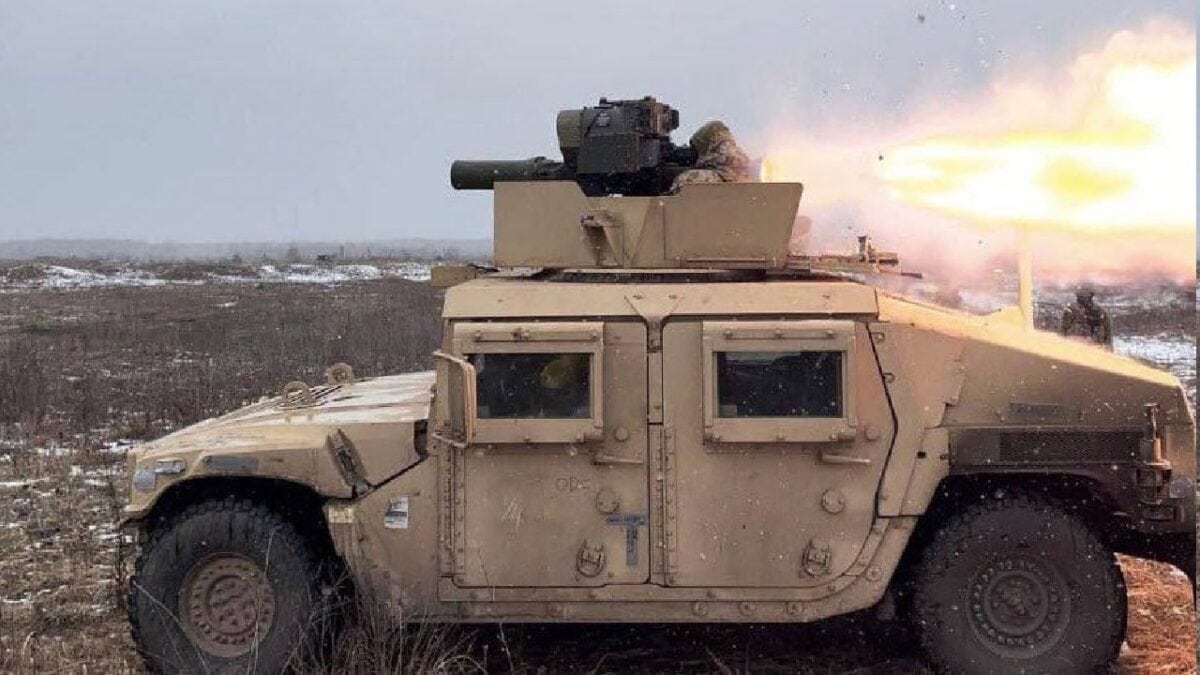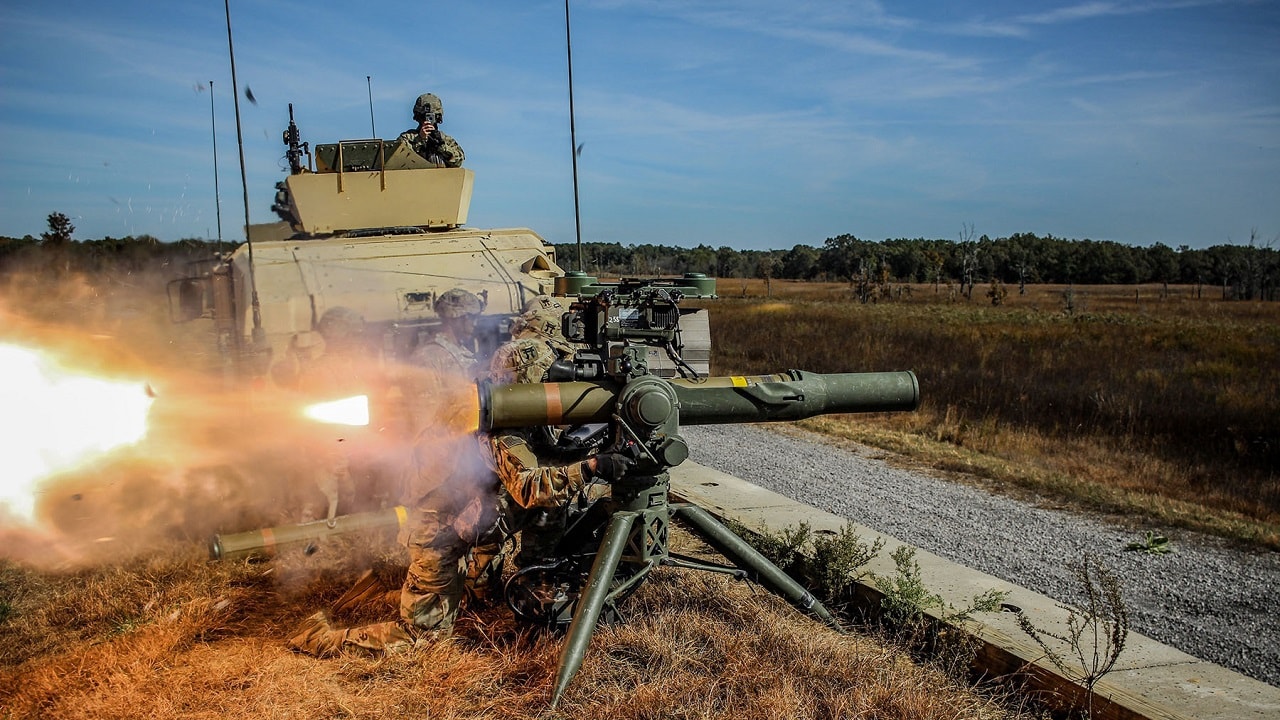Sure, there are countless anti-tank weapons being fired in Ukraine. Both sides have thousands of them currently in use.
And sure, the Javelin missile is the most popular and getting the most press.
However, the old TOW missile is still quite deadly and can do much damage on the battlefield. And Putin is learning this lesson daily.
Destroyed: Ukrainian TOW Rocket Destroying Russian Tanks
A video posted to social media by Ukraine Weapons Tracker (@UAWeapons) back in March highlights the capabilities of the American-made BGM-71 TOW (“Tube-launched, Optically tracked, Wire-Guided”) anti-tank missile.
In the more than a minute-long clip, which was seen to be heavily edited and recorded from multiple vantage points including from a drone, the weapon is seen being readied on a Ukrainian Humvee (HMMWV) and then fired at an enemy position.
“Designed to defeat fortifications, it can make a ~60cm hole in an 20cm thick double-reinforced concrete wall,” the post on Twitter noted.
TOW Can Go Toe-to-Toe With Armor
Development of the BGM-71 TOW began in the mid-1960s to replace the M40 106mm recoilless rifle as well as the MGM-32 ENTAC missile systems then in service. It was first employed in combat in the latter stages of the Vietnam War and was successfully used to destroy North Vietnamese People’s Army of Vietnam (PAVN) tanks near An Loc in May 1972.
The anti-tank weapon later saw service in the Iran-Iraq War – as the Islamic Republic of Iran Army used a number of TOW missiles that had been purchased before the Iranian Revolution of 1979, while others were obtained during the Iran-Contra affair. The TOW was then used in multiple engagements during Operation Desert Storm in 1991’s Persian Gulf War.
A decade later, the TOW received notoriety for being used by U.S. forces in the July 22, 2003 assault that killed Uday and Qusay Hussein – sons of Iraqi dictator Saddam Hussein. The missiles were fired on the house where the two men had taken refuge.
It has been employed in more than a dozen conflicts around the world, including the ongoing fighting in Syria and Yemen. It remains one of the most widely used anti-tank weapons in the world, with more than 650,000 produced. The TOW is expected to remain in service with the U.S. military until at least 2050.
Improved TOWs
The TOW missile has been steadily upgraded since it first entered service more than half a century ago. As previously reported, Raytheon Missile & Defense now produces the anti-tank missile, labeling the weapon as “the premier long-range, heavy assault-precision anti-armor, anti-fortification and anti-amphibious landing weapon system used throughout the world today,” adding that the “The TOW missile enables ground forces to achieve overmatch against adversary armored and wheeled systems, regardless of the environment or conditions.”
Though considered “man-portable,” the launchers are bulky. As a result, the M151 and M220 launchers are generally mounted on vehicles including the M966 HMMWV or M1045 HMMWV, as well as the M113 armored personnel carrier (APC).
Unlike smaller man-portable platforms including the FGM-148 Javelin, and Swedish AT4, the TOW missile is not a fire-and-forget weapon, and rather is a second-generation wire-guided missile where the guidance system is directly linked to the platform. This requires that the operator maintains a line of sight until the missile impacts the target.
Ukrainian TOW Missiles
Last August, the Pentagon announced that it would supply Kyiv with approximately 1,500 BGM-71 TOW missiles as part of a $775 million security assistance package. It is unclear when those anti-tank weapons arrived, but based on the recent video they’re now being employed at the front.
#Ukraine: Another missile type from the TOW family is now confirmed to be used by the AFU- this time a ???????? BGM-71H-1-RF TOW BB missile, guided via a radio-frequency link.
Designed to defeat fortifications, it can make a ~60cm hole in an 20cm thick double-reinforced concrete wall. pic.twitter.com/wSwaFW98yA
— ???????? Ukraine Weapons Tracker (@UAWeapons) March 29, 2023
The version seen in the recent clip was a TOW Bunker Buster (BB), a variant optimized for performance against urban structures, earthen bunkers, field fortifications, and light-skinned armor threats. The TOW BB has an impact sensor located in the main charge and optimizes warhead effectiveness. It can defeat double-reinforced concrete walls at range. Such weapons should be seen as bad news for the Russian troops in urban centers such as Bakhmut as Kyiv is preparing for its own counteroffensive.

Ukraine TOW Missile Attack
Author Experience and Expertise
A Senior Editor for 19FortyFive, Peter Suciu is a Michigan-based writer. He has contributed to more than four dozen magazines, newspapers, and websites with over 3,200 published pieces over a twenty-year career in journalism. He regularly writes about military hardware, firearms history, cybersecurity, politics, and international affairs. Peter is also a Contributing Writer for Forbes and Clearance Jobs. You can follow him on Twitter: @PeterSuciu.

